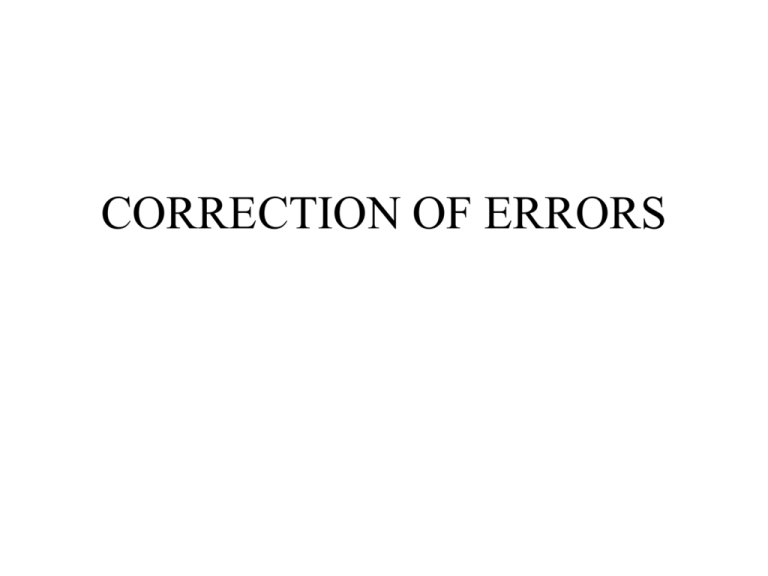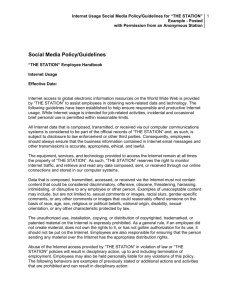CORRECTION OF ERRORS
advertisement

CORRECTION OF ERRORS An ERROR • is an unintentional mistake. • it is generally discovered months after the cut-off (accounts preparation) date. • it cannot be simply erased [rub out] or torn out when it (the ERROR) has been discovered ERRORS • must be corrected via the double-entry process – [1st ] The correction is to be recorded in the JOURNAL – [2nd ] The correction is to be posted in the LEDGERS ERRORS There are TWO types which may occur in the recording of accounting information: • those which DO NOT AFFECT the Trial Balance. • those which DO AFFECT the Trial Balance. ERRORS WHICH DO NOT AFFECT THE TRIAL BALANCE COMMISSION Where similar PERSONAL accounts become mixed up (mistaken) in posting OMISSION Where a valid transaction was NOT posted (omitted) IN THE BOOKS. PRINCIPLE Where a posting was made to the wrong TYPE of account REVERSAL OF ENTRY Where the clerk debited the side that should be credited; and credited the side that should be debited. ORIGINAL ENTRY Where the figures recorded IN THE BOOKS, for a valid transaction, were entered incorrectly from the very beginning. COMPENSATION Where one [addition/subtraction] mistake made on the debit side, is cancelled out by a similar mistake on the credit side. Correcting an error that DNATTB – Have the general journal at hand – analyze the mistake that was made – Determine action required to cancel the mistake – correct what is wrong! – Journalize the required action – Add the explanatory narrative ERRORS WHICH DO AFFECT THE TRIAL BALANCE CASTING (OVER/UNDER) Where the totalling of a set of figures are incorrectly stated ONE_HALF POSTING Where data was posted to only one of the two accounts involved in the transaction. [remember a transaction MUST be posted into TWO accounts] SAME_SIDE POSTING Where data was posted on the same side of both accounts involved in the transaction [eg both were debited]. TRANSPOSITION Where data was posted to corresponding accounts, but the figures on one of the accounts DO NOT match the figures on the other for that same transaction. The Suspense Account • ERRORS that do affect the trial balance require the services of the Suspense account. • It holds the cancelling half of the transaction, so as to prevent the clerk from changing the part of the posting that was already correct. • It follows the same rules for double-entry posting EXAMPLES (DNATTB) COMMISSION $250 paid by R Jones had been posted by us to R Joan’s account. OMISSION A purchases invoice for $340 goods from Gibbs was not entered in the books. PRINCIPLE A company van sold for $8000 had been entered in the sales account. REVERSAL OF ENTRY $30 for light had been debited in the Cash Book and credited on the Light a/c ORIGINAL ENTRY Cash sales for $324 had been entered in all of the books as $342 COMPENSATION Both discount columns on the Cash Book had been over added by $20 EXAMPLES (DATTB) OVER/UNDER CASTING The total on the Sales account should be $15600 and NOT $15650 ONE_HALF POSTING $250 paid by Jones to settle his account was not recorded in the Cashbook SAME_SIDE POSTING Sale of company van for $8000 was also debited in the (Sale of Assets)Van a/c TRANSPOSITION Purchases of $456 had been posted in the Cashbook as $546



